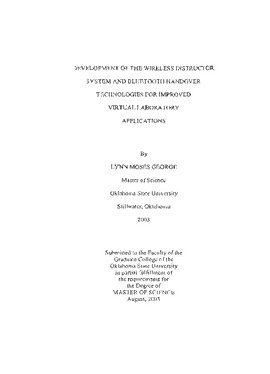| dc.contributor.author | George, Lynn Moses | |
| dc.date.accessioned | 2014-08-22T11:26:47Z | |
| dc.date.available | 2014-08-22T11:26:47Z | |
| dc.date.issued | 2003-08-01 | |
| dc.identifier.uri | https://hdl.handle.net/11244/10674 | |
| dc.description.abstract | The thesis presents the details of features and implementations of the Virtual Lab developed in the Telecommunication Laboratory (l04 Gundersen Hal)) of Oklahoma State University using Bluetooth as the crucial wireless link between the Instructor and the students. In a laboratory course where the lab is comprised of many rooms, the essential interactivity between students is lost as the Instructor needs to move between rooms. The Instructor does not have the capability to lecture and advice the students as the exercises are being done. The lecture session and the exercise session need to be separate. Moreover, distant students definitely need to travel to the campus to attend the Lab courses. These issues pertaining to a laboratory course were addressed and a solution, that took the form, Virtual Lab, has been fonnulated and developed. The project h.as been funded by the Department of Education for bringing up the interaction and application of high end technology in education. The Instructor is given the capability of moving around the rooms of a lab and always have contact with the students through the Compaq iPAQ PocketPC, which has been enhanced to function as per the requirements for the virtual lab through an application program developed for the purpose. The instructor is capable of sending files to the students from any place in the lab and the students are always aware of the InstlUctor's location and could page the Instructor with text messages. Moreover the students have been provided the added advantage of being able to see what the Instructor sees and listen to the lecture no matter which room the Instructor is in. The movement of the Instructor reqmres the wireless links to be checked for quality as the Instructor moves from one room to another, tear down bad links and form new stronger links. This procedure named Handover needs to be done in a manner that the normal traffic is not affected. The virtual lab needed efficient and fast algorithms for Handover and hence three new algorithms were developed and implemented and analyzed for speed. The virtual lab has been equipped with a Handover mechanism for switching for maintaining a strong link wherever the hlstructor may move in the Lab. | |
| dc.format | application/pdf | |
| dc.language | en_US | |
| dc.publisher | Oklahoma State University | |
| dc.rights | Copyright is held by the author who has granted the Oklahoma State University Library the non-exclusive right to share this material in its institutional repository. Contact Digital Library Services at lib-dls@okstate.edu or 405-744-9161 for the permission policy on the use, reproduction or distribution of this material. | |
| dc.title | Development of the Wireless Instructor System and Bluetooth Handover Technologies for Improved Virtual Laboratory Applications | |
| dc.type | text | |
| osu.filename | Thesis-2003-G348d.pdf | |
| osu.accesstype | Open Access | |
| dc.type.genre | Thesis | |
